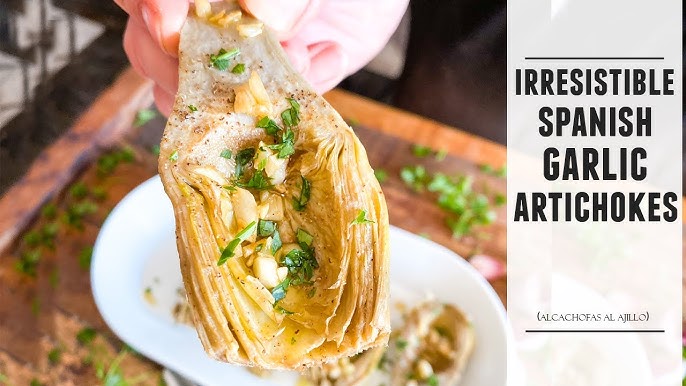Artichoke Recipe: Artichokes might look like some sort of medieval plant with their spiky leaves and complex appearance, but they’re actually one of the most delicious and versatile veggies around. Belonging to the thistle family, the edible part of the artichoke is actually the flower bud before it blooms. While they might seem intimidating to cook, with a little know-how, anyone can master the art of preparing them. They offer a unique flavor—somewhere between earthy and nutty—with a tender heart that food lovers crave. Whether you’re making them for a dinner party or a simple family meal, artichokes can elevate any dining experience.
Health Benefits of Artichokes
Not only are artichokes tasty, they’re also incredibly healthy. Packed with antioxidants, fiber, and essential nutrients like vitamin C, K, folate, and magnesium, artichokes are often considered a superfood. They help with digestion, support liver health, and even aid in lowering bad cholesterol levels. A single medium artichoke offers about 7 grams of fiber, making it an excellent choice for anyone looking to improve their digestive health. Plus, it’s low in fat and calories, which makes it a guilt-free addition to any meal. Adding artichokes to your diet is a smart move both for your palate and your body.
Choosing the Right Artichoke
How to Pick a Fresh Artichoke
Your culinary success starts at the store. When choosing artichokes, look for ones that are firm, heavy for their size, and have tightly packed leaves. The color should be vibrant green, with little to no browning or splitting. Another trick is to give the artichoke a gentle squeeze—it should squeak a little, which is a sign of freshness. Avoid artichokes that appear dry, have too much discoloration, or feel light and hollow; these are signs they may be old or overripe.
Tips for Storing Artichokes
If you’re not cooking them the same day, you can store artichokes in the refrigerator to keep them fresh. Wrap them in a damp paper towel and place them in a plastic bag to maintain moisture. Stored this way, they should last up to a week. Avoid washing the artichokes before storing as excess moisture can lead to mold. If you’ve already cooked them, store the leftovers in an airtight container in the fridge and consume them within 3 to 5 days.
Prepping the Artichoke
Tools You’ll Need
Before diving into prep work, gather your tools to make the job easier. Here’s what you’ll need:
- A sharp chef’s knife
- Kitchen shears
- A large pot or steamer
- Tongs
- A lemon (to prevent browning)
- A bowl of water
- A spoon (for scooping out the choke)
These tools will help you clean and prepare the artichokes efficiently and safely.
Step-by-Step Cleaning Instructions
- Rinse thoroughly – Start by rinsing the artichokes under cold water to remove any dirt or debris caught in the leaves.
- Trim the top – Use a sharp knife to cut off about 1 inch from the top of the artichoke. This removes the prickly tips.
- Snip the tips – With kitchen shears, trim the sharp tips from the remaining leaves.
- Trim the stem – You can trim the stem down to about 1 inch. Some people peel the stem and eat it as it’s an extension of the heart.
- Remove tough outer leaves – Peel away a few of the lower leaves near the base.
- Rub with lemon – To prevent browning, rub all the cut edges with a lemon half.
- Optional: Remove the choke – If you’re serving the artichokes whole, you can remove the choke (the fuzzy part at the center) after cooking. But if you’re stuffing them, you’ll want to remove it beforehand using a spoon.
Once cleaned, your artichokes are ready to be cooked using one of the many methods below.
Cooking Methods
Boiling Artichokes
Boiling is one of the most traditional and straightforward methods for cooking artichokes. It’s great for beginners because it requires minimal effort and delivers tender, flavorful results. To start, fill a large pot with enough water to submerge the artichokes and add a few lemon slices, a couple of garlic cloves, and a pinch of salt for added flavor. Bring the water to a rolling boil and carefully place the artichokes stem-side up into the pot.
Boil for 30 to 45 minutes depending on their size. You’ll know they’re done when you can easily pull off a leaf and the base is tender when pierced with a knife. Drain the artichokes upside down in a colander to remove excess water. This method keeps the flavor clean and allows for the artichoke’s natural taste to shine, especially when paired with a dipping sauce like garlic butter or lemon aioli.
Steaming Artichokes
Steaming is arguably the best method if you want to preserve the artichoke’s nutrients and flavor. It’s simple, requires no fancy equipment—just a steamer basket or insert—and yields tender leaves with a more concentrated taste. Start by filling a pot with a couple of inches of water and bring it to a simmer. Place the cleaned artichokes in the steamer basket, cover with a lid, and steam for 30 to 40 minutes.
Steaming is ideal for keeping the artichokes from becoming waterlogged, which can happen with boiling. Once steamed, serve with a flavorful dipping sauce. If you want to jazz it up, toss in herbs like thyme or rosemary to the water for a subtle infusion.
Roasting Artichokes
Roasting brings out a completely different flavor profile—smoky, nutty, and caramelized. To roast artichokes, slice them in half lengthwise and remove the choke. Drizzle with olive oil, sprinkle with salt, pepper, and maybe some garlic or Parmesan, then place them cut-side down on a baking sheet.
Roast in a 400°F (200°C) oven for about 35-45 minutes. The outer leaves will crisp slightly, and the heart becomes beautifully tender. This method is great for a rustic, earthy side dish that pairs well with grilled meats or Mediterranean meals. You can even roast them in foil packets for a mess-free option.
Grilling Artichokes
Grilling artichokes is a game-changer. After boiling or steaming them until just tender, slice in half, scoop out the choke, brush with olive oil and place them cut-side down on a hot grill. Grill for 5 to 10 minutes until you get nice char marks and a smoky flavor.
This method adds depth and complexity, perfect for summer cookouts or a bold appetizer. Serve with a cool, creamy dip to contrast the grilled texture. Bonus points if you sprinkle a little lemon juice or balsamic glaze over the top right before serving.
Step-by-Step Recipe for Steamed Artichokes
Ingredients Needed
Here’s what you’ll need to make simple, steamed artichokes:
- 2 large artichokes
- 1 lemon, halved
- 2 garlic cloves (optional)
- Bay leaves or herbs (optional for added flavor)
- Salt
- Dipping sauce (melted butter, aioli, vinaigrette)
Make sure your artichokes are clean and prepped before you start. This recipe is straightforward and perfect for beginners who want to savor the artichoke’s natural flavor without much fuss.
Cooking Instructions
- Prepare your steamer – Fill a large pot with 2 inches of water. Add the garlic and lemon halves to the water, place the steamer basket inside, and bring to a boil.
- Place artichokes in steamer – Position the artichokes cut-side down in the basket. Cover with a lid and reduce the heat to medium.
- Steam the artichokes – Let them steam for 30 to 45 minutes, depending on size. Check doneness by pulling off a leaf—it should come off easily—and testing the heart with a knife.
- Cool and serve – Once cooked, let them cool for a few minutes. Serve whole with your favorite dip or remove the leaves and serve the hearts sliced over a salad or pasta.
Serving Suggestions and Dips
Steamed artichokes are best enjoyed leaf by leaf. Simply dip the base of each leaf in your chosen sauce and scrape the soft part with your teeth. Popular dips include:
- Melted garlic butter
- Lemon herb aioli
- Balsamic vinaigrette
- Spicy mayo
Pair them with grilled chicken or fish for a light meal or serve as an elegant starter. You can also refrigerate leftovers and toss them in a salad the next day.
Creative Ways to Enjoy Artichokes
Stuffed Artichokes Recipe
If you want to impress guests or elevate your dinner, stuffed artichokes are a show-stopper. This dish is all about flavor-packed breadcrumbs tucked between each leaf. To make them, start by preparing your artichokes as usual—trim the leaves, snip the thorns, and scoop out the choke. Then, mix together breadcrumbs, grated Parmesan, minced garlic, parsley, olive oil, and lemon zest.
Spoon this mixture generously into the spaces between the leaves. Place the stuffed artichokes in a pot with a bit of water, cover, and simmer for 40–50 minutes until tender. The result? A crispy, garlicky stuffing with every bite, and a heart that’s tender and delicious. It’s a comfort food classic in Italian households and perfect for holidays or dinner parties.
Artichoke Dip Variations
Artichoke dip is arguably the most famous use of this vegetable in American cuisine. While the classic version involves mayo, cream cheese, spinach, and artichokes, there are countless ways to mix it up:
- Baked Cheesy Artichoke Dip: Add mozzarella and bake until golden and bubbly.
- Healthy Greek Yogurt Artichoke Dip: Swap mayo for Greek yogurt for a lighter version.
- Spicy Jalapeño Artichoke Dip: Add chopped jalapeños for a kick.
Serve warm with toasted bread, crackers, or veggie sticks. It’s a surefire crowd-pleaser for game nights, potlucks, and family gatherings.
Incorporating Artichokes in Pasta and Salads
Artichokes aren’t just a side dish—they can be the star of your main course. Try tossing marinated artichoke hearts into your favorite pasta with sun-dried tomatoes, olives, and feta for a Mediterranean flair. You can also add them to risottos, casseroles, or even pizza for a gourmet twist.
For salads, artichokes work beautifully with arugula, cherry tomatoes, and lemon vinaigrette. Their tangy, briny flavor cuts through richer elements like goat cheese or avocado. Whether fresh, cooked, or jarred, artichokes add texture and taste that turns a boring salad into something you’ll crave.
Common Mistakes to Avoid When Cooking Artichokes
Overcooking or Undercooking
Timing is everything when it comes to cooking artichokes. Undercooked artichokes are tough and bitter, while overcooked ones become mushy and lose their structure. Always test by pulling off a leaf and checking for tenderness at the base. You should also pierce the stem or heart with a knife—it should glide in easily, like a cooked potato.
Skipping the Lemon Rub
Artichokes oxidize quickly once cut, turning brown and unappetizing. Always rub cut surfaces with a lemon half to prevent discoloration. It not only keeps them looking fresh but also adds a zesty note to the flavor.
Not Removing the Choke Properly
The fuzzy center—called the choke—should always be removed before serving. It’s inedible and can ruin the eating experience if left in. Use a spoon to gently scoop it out after cooking if you didn’t remove it earlier.
Tips for First-Time Artichoke Cooks
If this is your first time cooking artichokes, keep it simple. Start with the steaming method to familiarize yourself with the texture and flavor. Use a quality dipping sauce, and don’t worry if you don’t get every leaf perfectly trimmed. Like any kitchen skill, artichoke prep gets easier with practice.
Use a large pot, give yourself plenty of time, and enjoy the process. Cooking artichokes is less about perfection and more about discovering a fun, hands-on way to eat veggies. Plus, there’s something satisfying about working your way to the tender heart—like a little edible treasure hunt.
FAQs About Artichoke Recipe
Q1: What’s the best way to cook artichokes?
The most popular methods are steaming, boiling, roasting, and grilling. Steaming is often preferred as it keeps the flavor intact and retains nutrients.
Q2: How do I know when artichokes are done cooking?
They’re ready when a knife easily pierces the base, and the outer leaves pull off with little resistance. This usually takes 25–45 minutes, depending on the size and method.
Q3: Can I eat the entire artichoke?
Not entirely. Only the tender base of each leaf and the heart (after removing the fuzzy choke) are edible. Avoid eating the fibrous choke or tough outer leaves.
Q4: What dips go well with artichokes?
Melted butter, garlic aioli, lemon mayo, hollandaise, or balsamic vinaigrette are delicious dipping options that enhance the flavor.
Q5: How do I store cooked artichokes?
Cool them completely, then store in an airtight container in the refrigerator for up to 3–4 days. Reheat by steaming or microwaving.
Q6: Are artichokes good for you?
Yes! They’re high in fiber, antioxidants, and vitamins C and K. Artichokes also support digestion and liver health.
Q7: Can I prepare artichokes ahead of time?
Absolutely. You can trim and prep them a few hours ahead. To prevent browning, soak them in lemon water until ready to cook.
Conclusion
Artichokes are one of those misunderstood veggies that scare people off with their tough exterior, but once you understand how to prepare and cook them, they become an irresistible addition to your culinary routine. From steaming and boiling to roasting and grilling, artichokes offer incredible versatility. Add them to salads, stuff them for a gourmet twist, or serve them with a side of garlic butter for a satisfying appetizer.
They’re not only flavorful but also packed with health benefits. So whether you’re a kitchen newbie or an experienced cook, this step-by-step guide gives you everything you need to confidently make and enjoy artichokes at home.



